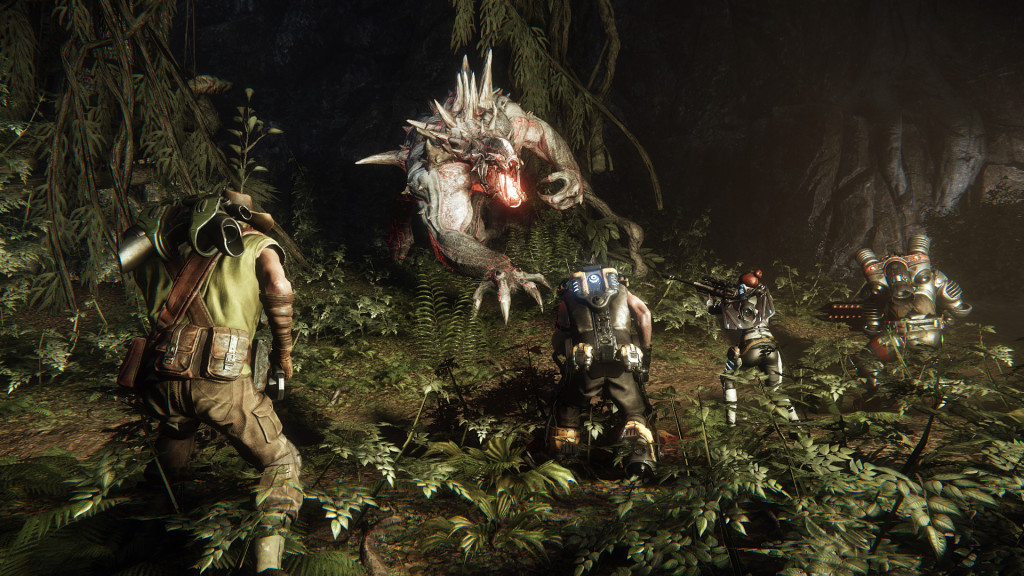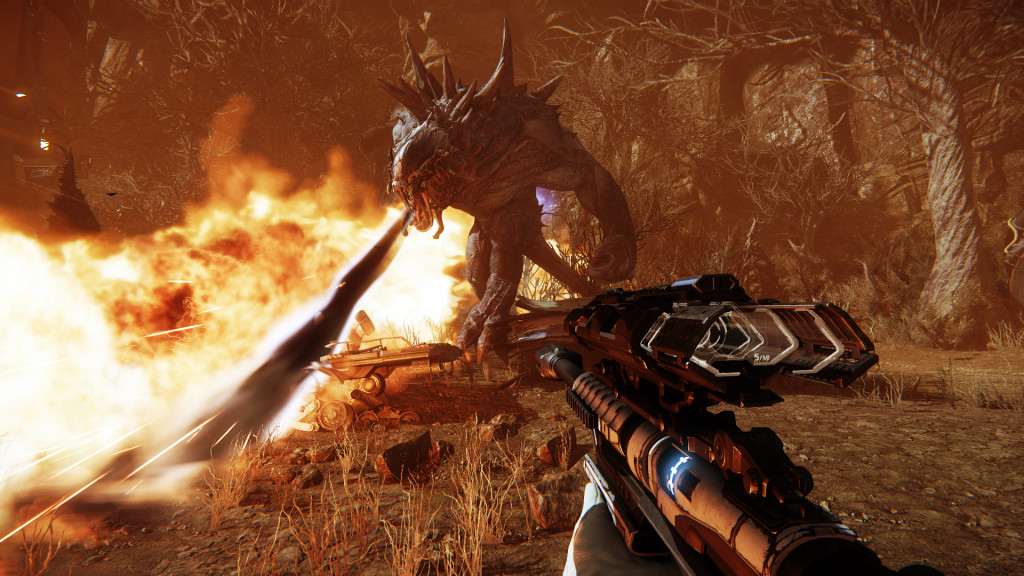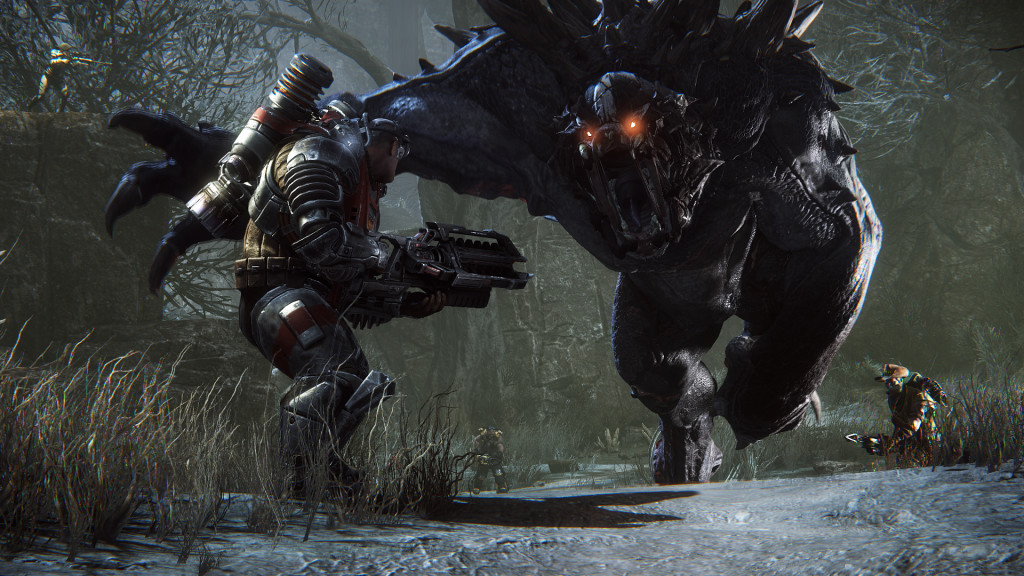
In 2008, Turtle Rock Studios evolved the cooperative shooter with the landmark release Left 4 Dead. In the years since that title’s release, there have been other developers pushing the genre forward by iterating on that original blueprint. With Evolve, Turtle Rock Studios sets out to make the next big leap in this game space again by focusing on asymmetrical gameplay. The result is an interesting concept that plays unlike nearly anything else I’ve experienced, and is incredibly exciting and fun when it works on all fronts. Unfortunately, far too often the actual matches fall far short of this occasional glimmer, and a frustratingly slow progression system makes the game feel more sluggish than fun.
The core concept of Evolve lies in the idea of pitting four human-controlled hunters against one human-controlled monster in an arena battle. This core facet of four-on-one asymmetric multiplayer appears like it would be nightmarish to balance, and this is further complicated by the fact that there are three different monsters and four different hunter classes (with three different playable characters each). All of these playable classes and characters each have their own abilities and actually play quite differently. There is even further customization, too, with different perks that can be selected before the battle begins. To Turtle Rock’s credit though, in a match where all the players involved are of roughly equal skill, I found the gameplay to be incredibly well-balanced and the final outcomes were often tense and to the wire.
The key problem occurs when there is even one player (or AI) that is below the playing level of the rest of the group. For the hunters to really have a chance against the monster, each available class needs to be able to perform a specific role. The assault class is responsible for dealing the heavy damage, while the support class does various things like increasing ally movement speed or shielding allies from damage, and if either player of these two classes lags behind in their play, then the entire human team will be drawn into a prolonged battle. In Evolve, longer games equate to a more likely monster victory. The medic class, which is responsible for healing allies, and the trapper class, that works to contain and slow the monster, however, are essential for a hunter win. The monster can deal damage very quickly, and if the medic goes down, the rest of the group will likely fall soon after, and without a competent trapper the monster will have a chance to escape if the battle seems to be turning the wrong way. Because of this, the monster wins far more often, and my time spent playing the monster felt somehow cheapened as I bulldozed through many enemy groups.

The most interesting part of a match of Evolve (and the part that typically predicts the winning side) occurs right at the beginning. The monster is given a head start on the hunters, and during this time needs to gain some ground and hide while killing and feeding on wildlife until gaining enough experience to evolve. If the hunters are able to find the monster during this “level one” evolutionary stage, they have a distinct advantage. If the monster can eat enough to evolve to level two, however, the playing field becomes more even, and at level three the hunters are in a lot of trouble. Also at level three, the monster is able to attack a location on the map that signals victory if destroyed, giving an alternate win condition from killing all the hunters thereby forcing them to fight the losing battle against their formidable foe. From the other side, the hunters are trying to find and contain the monster as quickly as possible, and this involves looking for the monster’s tracks as well as watching for other clues like frightened birds that flee from the monster’s location. This early game of cat-and-mouse is really fun, and had my heart racing more than the actual confrontation later in the match.
There are two main ways to play Evolve, and these are in single-match Hunts or the multiple-mission Evacuation mode. The single-match mode is simple for a quick fix, but Evacuation allows both the monster and hunter side multiple games to earn bonuses and learn strategies to defeat one another. Each time a team wins in Evacuation, the next map is modified in some way to aid them in the next battle. The game modes vary a bit more here as well, as there are objectives to defend or people to rescue and the game doesn’t just become about fighting the other side. All of these modes can be played solo, too, and while this might seem like a waste I found that I gravitated to solo play after one or two losses just to practice or play without the complication of other players (be it good or bad). Evolve lets you use the directional buttons to quickly swap between the hunters in the arena, so you never feel like you are leaving your entire game up to the AI at any point.

Evolve gets stale pretty quickly in the early going, and this is absolutely due to the lack of choice a new player is given when it comes to customization. To unlock any of the higher-tiered characters in a given class, you are required to pass a rank with each of the lower-tiered character’s weapons. This means that to unlock, for example, the second playable assault character, you must do enough damage with the initial assault character’s rifle, lightning gun and mines. This can take a very long time, and actually encourages sub-optimal play online where, for example, I would end up spamming a weapon in a situation I shouldn’t be just to increase my rank and unlock the next tier. There are a lot of interesting play styles that Evolve allows for with any given class, but watching the very slow movement of progress bars game after game feels too much like wheels spinning without a tangible reward.
With a dedicated group of five all playing on headsets yelling for help and trading turns as the monster, Evolve provides a multiplayer experience that could easily fight for a spot at the top. When playing alone or with strangers, though, the bright shine dulls quite a bit and the problem of balancing a game this complex becomes very apparent. Back in the era of LAN parties this would have been the first game on my list, but the learning curve and rate of progression make it a tough sell in today’s gaming landscape.
Pros: Highly tactical gameplay, variety of play styles supported
Cons: Requires communicative groups, long matchmaking and loading times



















